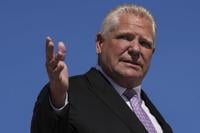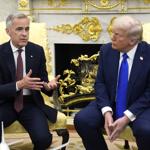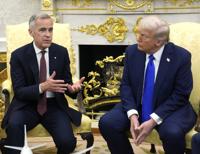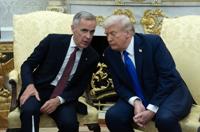OTTAWA - Most economists expect the Bank of Canada will look past strong jobs data and signs of stubbornness on the inflation front to deliver a second consecutive interest rate cut this week.
BMO chief economist Doug Porter is among those expecting a second straight cut on Wednesday, but he admits recent economic data hasn't perfectly lined up with that call.
"The two major economic reports we've had since the Bank of Canada last decided on interest rates were a strong jobs report and a bit higher than expected inflation report," he said in an interview.
"Taken in isolation, you would think there's no reason for the bank to be cutting interest rates."
The Bank of Canada lowered its benchmark interest rate by a quarter point to 2.5 per cent in late September, snapping a streak of three consecutive rate holds since March.
As of Friday, LSEG Data & Analytics put financial market odds at more than 80 per cent in favour of a second quarter-point cut at the central bank's decision on Wednesday.
Earlier this month, Statistics Canada reported a surprise gain of roughly 60,000 jobs in September. Inflation data for that month also accelerated to 2.4 per cent, up half a percentage point from August, with the Bank of Canada's preferred measures of core inflation holding above three per cent.
The central bank uses various definitions of "core" inflation to strip out volatile influences on the consumer price index and get a better sense of where inflation is headed.
Porter said the firm September inflation report "did make it a little tougher to cut rates."
He said the Bank of Canada could still surprise with a hold this week, but he's putting more stock in the broader economic context to inform BMO's rate call for a cut.
Despite the surprise employment gain in September, the labour market has barely posted any job growth since January as U.S. trade uncertainty restrains businesses' hiring appetites.
Porter argued that Canada's jobs market needs relief from lower rates with the unemployment rate still elevated at 7.1 per cent.
The Bank of Canada has also cast some doubt on the reliability of its own core inflation metrics, instead telling ºÚÁϳԹÏÍøs that monetary policymakers see inflation around 2.5 per cent right now. Porter said some other core inflation measures from September are in line with that reading.
"We think they should proceed carefully here, but ultimately they should proceed with lower rates," he said.
Economists at RBC also believe the Bank of Canada has a tough call to make this week.
Economists Nathan Janzen and Claire Fan said in a note to clients that signs of weakness in the labour market and lower inflation expectations in the central bank's business outlook survey published last week should give monetary policymakers confidence that inflation will cool further going forward.
"This essentially means more room and flexibility for the central bank to have looser monetary policy," they wrote.
But to see further cuts past this, the economy would need to deteriorate more sharply than RBC is currently forecasting. Fan and Janzen argue fiscal policy from the federal government is best suited to address ongoing sectoral pain from U.S. tariffs.
The Bank of Canada will have to make its rate decision before getting a sense of the federal government's spending plans coming in the fall budget on Nov. 4.
BMO sees the Bank of Canada continuing to cut interest rates to a low of two per cent before finishing the current easing cycle -- among the lowest terminal rates currently expected by major forecasters.
Outside of the hard numbers, Porter said recent announcements that automakers Stellantis and GM are either pausing some ºÚÁϳԹÏÍø production or moving it south of the border show what an "exceptionally challenging" time it is for the economy.
While he also expects stimulative government spending to come from the federal budget next month, he said Canada is grappling with "once in a lifetime uncertainty on the trade front," warranting a strong response from both monetary and fiscal policy.
The Bank of Canada doesn't know yet where government spending plans will end up — and how much the budget could fuel inflation — but Porter said it's nonetheless appropriate for both monetary and fiscal policy to be rowing in the same direction.
"You don't want to see those two policies working against each other usually. And I think that's what we have here," he said.
"A bit of support from the the fiscal oar and a little bit of support from lower interest rates, the monetary oar."
The Bank of Canada has also signalled it will return to publishing a single, central forecast for the economy. In an updated monetary policy report accompanying the rate decision on Wednesday. The central bank had  published illustrative scenarios for the past two quarters based on how U.S. tariff policy might evolve.
This report by ºÚÁϳԹÏÍø was first published Oct. 27, 2025.














































